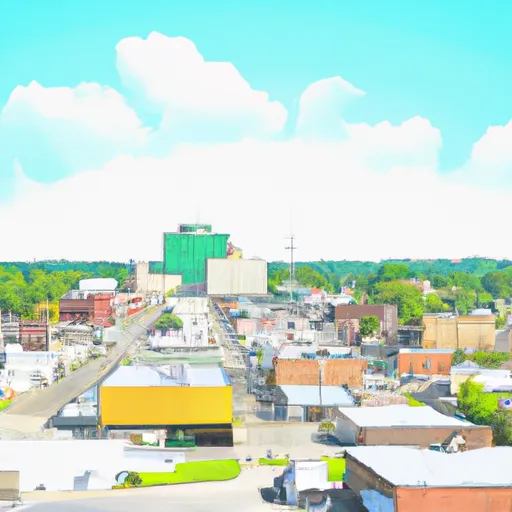-
 Snoflo Premium
Snoflo Premium
Get unlimited access to all our content
With no Ad interruptions! - Start Your Free Trial Login with existing account
Lawton
Eden Index
Climate
8.2
•
Recreation
2.8
•
Community
1.5
•
Safeguard
4.7/10

Lawton, Kentucky is a charming town located in the northeastern part of the state. The climate in Lawton can be described as temperate, with hot summers and mild winters. Summers are typically humid, with temperatures averaging in the high 80s°F, while winters are relatively cool with temperatures averaging in the low 40s°F.
Lawton is blessed with numerous hydrology constituents, including the scenic Lawton River that runs through the town. This river provides opportunities for fishing, kayaking, and canoeing. The river is also home to a variety of wildlife, making it a popular spot for birdwatching and nature enthusiasts.
Outdoor recreation is a major highlight in Lawton. The town is surrounded by stunning natural landscapes, including lush forests, rolling hills, and picturesque trails. Hiking and camping are popular activities in the area, with several parks and recreational areas nearby. The Lawton State Park offers camping facilities, picnic areas, and miles of hiking trails, while the Lawton National Forest boasts breathtaking scenery and opportunities for wildlife observation. Whether you enjoy fishing, hiking, or simply immersing yourself in nature, Lawton provides ample opportunities for outdoor recreation.
What is the Eden Index?
The Snoflo Eden Index serves as a comprehensive rating system for regions, evaluating their desirability through a holistic assessment of climate health, outdoor recreation opportunities, and natural disaster risk, acknowledging the profound impact of these factors on livability and well-being.
Climate Health Indicator (CHI): 8.2
Lawton receives approximately
1158mm of rain per year,
with humidity levels near 82%
and air temperatures averaging around
12°C.
Lawton has a plant hardyness factor of
6, meaning
plants and agriculture in this region thrive during a short period during spring and early summer. Most
plants will die off during the colder winter months.
By considering the ideal temperature range, reliable water supplies, clean air, and stable seasonal rain or snowpacks, the Climate Health Indicator (CHI) underscores the significance of a healthy climate as the foundation for quality living.
A healthy climate is paramount for ensuring a high quality of life and livability in a region, fostering both physical well-being and environmental harmony. This can be characterized by ideal temperatures, reliable access to water supplies, clean air, and consistent seasonal rain or snowpacks.
Weather Forecast
Streamflow Conditions
Middle Ohio-Raccoon
Area Rivers
Middle Ohio-Raccoon
Snowpack Depths
Middle Ohio-Raccoon
Reservoir Storage Capacity
Middle Ohio-Raccoon
Groundwater Levels
Recreational Opportunity Index (ROI): 2.8
The Recreational Opportunity Index (ROI) recognizes the value of outdoor recreational options, such as parks, hiking trails, camping sites, and fishing spots, while acknowledging that climate plays a pivotal role in ensuring the comfort and consistency of these experiences.
Access to outdoor recreational opportunities, encompassing activities such as parks, hiking, camping, and fishing, is crucial for overall well-being, and the climate plays a pivotal role in enabling and enhancing these experiences, ensuring that individuals can engage in nature-based activities comfortably and consistently.
Camping Areas
| Campground | Campsites | Reservations | Toilets | Showers | Elevation |
|---|---|---|---|---|---|
| Paragon | 9 | 731 ft | |||
| North Fork - DFWR | None | 734 ft | |||
| Trace Branch - Buckhorn Lake | 20 | 865 ft | |||
| Carr Creek State Park | 40 | 1,093 ft |
Nearby Ski Areas
Catastrophe Safeguard Index (CSI):
The Catastrophe Safeguard Index (CSI) recognizes that natural disaster risk, encompassing floods, fires, hurricanes, and tornadoes, can drastically affect safety and the overall appeal of an area.
The level of natural disaster risk in a region significantly affects safety and the overall livability, with climate change amplifying these risks by potentially increasing the frequency and intensity of events like floods, fires, hurricanes, and tornadoes, thereby posing substantial challenges to community resilience and well-being.
Community Resilience Indicator (CRI): 1.5
The Community Resilience Indicator (CRI) recognizes that education, healthcare, and socioeconomics are crucial to the well-being of a region. The CRI acknowledges the profound impact of these elements on residents' overall quality of life. By evaluating educational resources, healthcare accessibility, and economic inclusivity, the index captures the essential aspects that contribute to a thriving community, fostering resident satisfaction, equity, and social cohesion.

